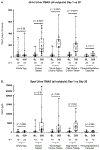Dietary Choline Supplements, but Not Eggs, Raise Fasting TMAO Levels in Participants with Normal Renal Function: A Randomized Clinical Trial
- PMID: 33872583
- PMCID: PMC8410632
- DOI: 10.1016/j.amjmed.2021.03.016
Dietary Choline Supplements, but Not Eggs, Raise Fasting TMAO Levels in Participants with Normal Renal Function: A Randomized Clinical Trial
Abstract
Background: Choline is a dietary precursor to the gut microbial generation of the prothrombotic and proatherogenic metabolite trimethylamine-N-oxide (TMAO). Eggs are rich in choline, yet the impact of habitual egg consumption on TMAO levels and platelet function in human subjects remains unclear.
Methods: Healthy volunteers (41% male, 81% Caucasian, median age 28 years) with normal renal function (estimated glomerular filtration rate >60) were recruited and assigned to 1 of 5 daily interventions for 4 weeks: 1) hardboiled eggs (n = 18); 2) choline bitartrate supplements (n = 20); 3) hardboiled eggs + choline bitartrate supplements (n = 16); 4) egg whites + choline bitartrate supplements (n = 18); 5) phosphatidylcholine supplements (n = 10). Fasting blood and urine samples were collected for quantification of TMAO, its precursors, and platelet aggregometry.
Results: Participants' plasma TMAO levels increased significantly in all 3 intervention arms containing choline bitartrate (all P < .0001), but daily ingestion of 4 large eggs (P = .28) or phosphatidylcholine supplements (P = .27) failed to increase plasma TMAO levels. Platelet reactivity also significantly increased in the 3 intervention arms containing choline bitartrate (all P < .01), but not with eggs (P = .10) or phosphatidylcholine supplements (P = .79).
Conclusions: Despite high choline content in egg yolks, healthy participants consuming 4 eggs daily showed no significant increase in TMAO or platelet reactivity. However, choline bitartrate supplements providing comparable total choline raised both TMAO and platelet reactivity, demonstrating that the form and source of dietary choline differentially contributes to systemic TMAO levels and platelet responsiveness.
Trial registration: ClinicalTrials.gov NCT03039023.
Keywords: Choline; Eggs; TMAO.
Copyright © 2021 Elsevier Inc. All rights reserved.
Conflict of interest statement
Conflict of Interest Disclosures:
SLH reports being named as co-inventor on pending and issued patents held by the Cleveland Clinic relating to cardiovascular diagnostics and therapeutics, being a paid consultant for Procter & Gamble, and having received research funds from Procter & Gamble, and Roche Diagnostics. SLH also reports being eligible to receive royalty payments for inventions or discoveries related to cardiovascular diagnostics or therapeutics from Cleveland Heart Lab and Procter & Gamble. WT served as a paid consultant for Sequana Medical AG and received honoraria from Springer Nature and American Board of Internal Medicine, all unrelated to the present topic. The other authors have reported that they have no relationships relevant to the contents of this paper to disclose.
Figures




References
-
- Koeth RA, Wang Z, Levison BS, Buffa JA, Org E, Sheehy BT, Britt EB, Fu X, Wu Y, Li L, Smith JD, DiDonato JA, Chen J, Li H, Wu GD, Lewis JD, Warrier M, Brown JM, Krauss RM, Tang WH, Bushman FD, Lusis AJ, Hazen SL. Intestinal microbiota metabolism of l-carnitine, a nutrient in red meat, promotes atherosclerosis. Nat Med. 2013;19:576–585 - PMC - PubMed
Publication types
MeSH terms
Substances
Associated data
Grants and funding
LinkOut - more resources
Full Text Sources
Other Literature Sources
Medical

